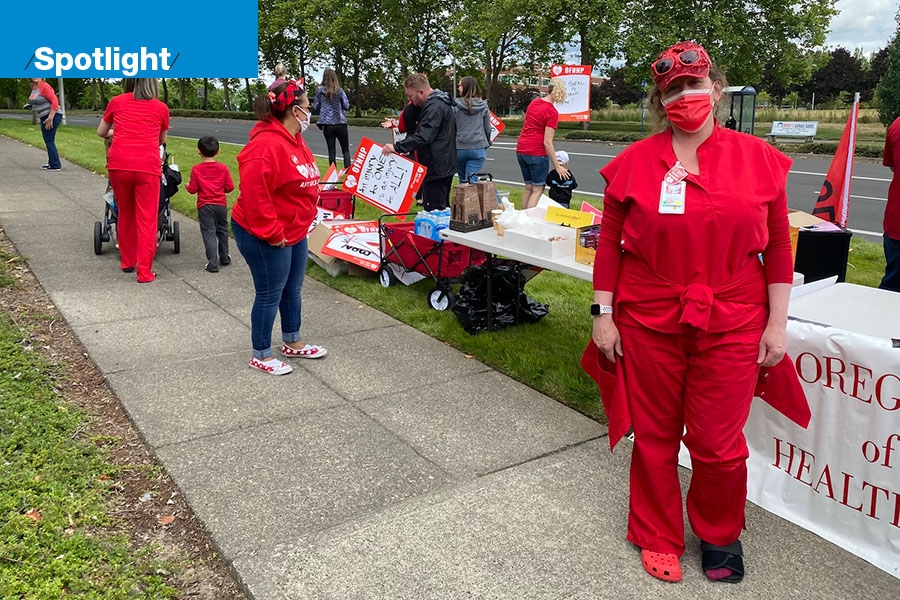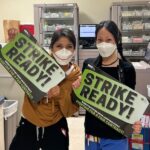After battling the COVID-19 pandemic for more than a year, Oregon nurses are burned out and recoiling from trauma.
At 7 p.m. on March 27, 2020, a chorus of bangs and cheers echoed between high-rise apartment buildings and front yards across Portland. It was the first night of noise-making in support of health care workers who were suddenly on the front lines of a global pandemic. Hospitals were filling up, people were dying and personal protective equipment (PPE) was in short supply.
Four hundred and thirty-seven days later, on June 9, 2021, more than 600,000 Americans had died of COVID-19, and there was no clatter of pots and pans as Mindy Schiebler prepared dinner for her kids — even in her own kitchen. The nightly ritual of cheering for health care workers faded a few months into the pandemic, and Schiebler didn’t have time to cook. That night’s meal consisted of raw, chopped veggies, fruit, and raspberry-fig bars.
“We try to eat healthy,” says Schiebler, whose children range in age from 16 to 24.
Schiebler is a widow; her late husband was also a nurse. From 8 p.m. to 9 p.m. she napped, then she drove 30 minutes from her home in Vancouver, Wash., to the Kaiser Sunnyside campus in Clackamas, where she works as an R.N. in the Cardiac Progressive Care Unit. Her shift started at 10 p.m.
Eight hours later, she left the floor and drove across Portland to the Kaiser Westside campus, where she spent 12 hours on a street corner with fellow nurses, holding signs that read “Safe staffing now!” and “Honk if you love nurses.”
The informational picket, organized by the Oregon Federation of Nurses & Health Professionals (OFNHP), was one of several attempts to call public attention to short- staffing at Kaiser Permanente facilities.
An established partnership between Kaiser and union employees is meant to ensure staff have a seat at the table in addressing issues like short-staffing. But nurses say they’ve been cut out of that conversation, and that staff shortages are impacting the quality of care they’re able to provide patients.
“There’s been a lot of talk in the public about how health care workers are heroes,” says Ben Dawson, a registered nurse at Kaiser Sunnyside. “Our employers certainly haven’t treated us that way.”
It’s been over a year since the first surge of COVID-19 patients in Oregon. Vaccines are now widely available, and cases have dropped significantly. But Oregon nurses, along with nurses across the country, are still reporting widespread exhaustion, low morale and not enough staff to properly cover patients’ needs. The Oregonian recently reported an “unprecedented” 20% of nurses at Oregon State Hospital in Salem who are currently on “coronavirus-related leave.”
With public attention turning to recovery and reopening, nurses are struggling to keep up with persistently high patient loads.
“COVID-19 exacerbated the issue of short-staffing,” says Dawson. “But it certainly didn’t start with the pandemic — it’s been a long-standing problem.”
Jessica Monego, emergency department nurse manager at Providence Portland Medical Center, says morale is lower now than at the height of COVID-19 hospitalizations. “There’s been no reprieve from the stress,” she says of her emergency-room staff, who have been experiencing high rates of violence and aggression from patients, likely due to so many people delaying mental-health care for the past year.
Serena Rohr, an R.N. and emergency-room coordinated caregiver at Kaiser, has been a nurse for over 16 years. “I’ve seen ups and downs. This is the lowest point.”
In response to the requests being made by OFNHP, Michael G. Foley, director of integrated communications at Kaiser, provided Oregon Business with a written statement:
“We are deeply grateful to our medical teams, nurses, and employees who expertly and compassionately care for and protect our members, patients, communities, and each other. At the same time, we are actively working to fill open positions throughout the hospital, especially nursing positions that remain in high demand as a result of the pandemic.”
Jorgi Heikkile graduated from the OHSU School of Nursing in La Grande this June. Having undergone multiple surgeries as a child, Heikkile remembers the kindness and care provided by her nurses. They are the ones who made her want to be a nurse herself.
Heikkile was in her second of a three-year program when the pandemic forced all of her classes to move online, and simulations replaced in-person clinicals.
“It’s been extra stressful to be a nursing student during COVID,” says Heikkile. “Overall, it made me wish I was already a nurse. I could have cared for those patients.”
While Heikkile was taking classes online, working nurses were thrust into the spotlight, their work called “heroic” as they cared for dying patients whose families were not allowed to be with them in the final moments.
“As nurses, we feel like we care for the patients and their family,” says Jennifer Burrows, Providence St. Vincent Medical Center chief executive, who served as Providence Oregon chief clinical and nursing officer until March 2021. “To not be able to have the family participate for comfort, for reinforcing education, for support—that was really hard.”
Despite the ongoing exhaustion and devastation health care workers have faced, and the public nature of that struggle, their work has inspired a surge of interest in the profession. It’s been called “The Fauci Effect”; according to the Association of American Medical Colleges, applications for medical school have increased 18% over the past year—and interest in nursing has seen a similar trajectory.
“COVID-19 has pulled back the curtain and shown us the tremendous lengths nurses go to every day to keep us safe and healthy,” says Kevin Mealy, communications manager with the Oregon Nurses Association. “More students are seeing nurses’ examples and asking how they can get involved and make a difference.”
Heikkile says that despite a frustrating year in which they lost out on significant in-person training and the support that usually comes with spending time with classmates, she and her peers are excited to start working.
Burrows has seen that enthusiasm in new nurses already. “They’re like ‘I’m ready, I’m prepared, I can help.’ That lets me know the right people are coming into the profession.”
But the current class of new nurses and the wave of new students interested in the profession do little to ease the unmanageable workload being faced by nurses like Schiebler right now.
Burrows says “shortages” is a misnomer for the real issue at hand.
“We have a lot of new nurses, a lot of graduating nurses and a shortage in the number who have been in the profession for a long time. It’s a mismatch in experience needed for the complexity of our patients.”
Many nursing professionals point to a pipeline problem in Oregon. A report from the Oregon Center for Nursing highlights the key challenge of employing enough nurse educators to keep up with the demand of interested students. The report states: “It is challenging to recruit and retain nurse educators because salaries are not competitive with practicing nurse salaries, nursing educator workload is high, and the cost to become a nurse educator is substantial.”
This is not just an Oregon problem but a nationwide one.
The American Association of Colleges of Nursing reports over 80,000 applicants from baccalaureate and graduate nursing programs were turned away from U.S. nursing schools from 2019-2020 due to “insufficient number of faculty, clinical sites, classroom space, clinical preceptors, and budget constraints.”
Mealy says clinical placements are also in short supply, and the staff shortages impact the speed at which new nurses can be trained up. “You need nurses overseeing this training period on the hospital grounds. That’s one area where we absolutely need to improve.”
New nurses and interested applicants could someday work alongside Schiebler, or any of the many nurses who are in desperate need of additional colleagues. But only if the education, positions and career-long support is provided to make this critical career one that is logistically, physically and emotionally sustainable for those who pursue it.
“We’ve experienced a level of social trauma,” says Burrows of the past year. “And like any trauma, people are still processing after the fact.”
Burrows says building resilience will be key in moving forward. “We need to continue to foster and grow that.”
Monego’s emergency-department team has been working on supporting one another and paying more attention to their own well-being. “We had everyone create a self-care goal—when they’re not at work, what are they doing to take care of themselves?”
Schiebler was still dressed in her red scrubs at the picket. She wore a sparkly red baseball hat and red sunglasses, tired eyes peeking between her hat and a red mask. On her foot she wore a walking boot for an injury acquired in mid-May, outside of work. Schiebler says she has not been given a referral to see an orthopedic doctor in person, despite multiple video visits with internal medicine doctors and ongoing pain.
“My doctor offered me a note off from work,” she says. “I don’t want a note. I want to serve my patients.”
When I ask her what keeps her going—despite systemic staffing shortages, despite the trauma, despite exhaustion — Schiebler looks down briefly, then meets my eyes. “You,” she says simply.
“It could be any one of us in that bed.”
To subscribe to Oregon Business, click here.








